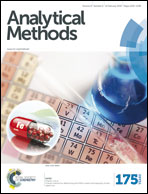A new sample preparation method for WD-XRF analysis of sulfide ores by fusion techniques: a BN crucible for protection against contamination and quantitative retention of sulfur†
Abstract
In this article, a methodology is described for the wavelength-dispersive X-ray fluorescence analysis of sulfide ores by fusion techniques. A boron nitride crucible is successfully utilised during pre-oxidation with no adhesion of sample powder and contamination. The combination of oxidant LiNO3 and flux Li2B4O7 at a mass ratio of 20 : 80 is demonstrated to be suitable for the quantitative retention of sulfur and the formation of homogeneous sample beads. The optical oxidation parameters, obtained by an orthogonal experiment L9(34) using the results obtained from the sulfur retention ratio using the sulfur analyser, for the quantitative retention of sulfur are as follows: temperature, 650 °C; time, 30 min and dilution ratio, 1 : 30. Fusion at 1000 °C indicates that sulfur does not volatilise as Li2SO4. The quantitative retention of sulfur in the entire process is validated by independent methods, such as X-ray diffraction, thermogravimetry-differential thermal analysis, as well as by the use of a sulfur analyser and analysis of reference materials. Moreover, 13 major elements present in sulfide ores were simultaneously and rapidly measured with precision and safety.


 Please wait while we load your content...
Please wait while we load your content...